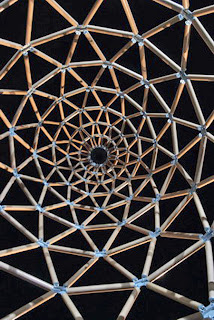 Paper Tower in London, 2009
Paper Tower in London, 2009
Shigeru Ban's
paper tower is part of the size matter project which matches leading architects and designers with a chosen material, asking them to push
the boundaries of that material's potential, and to also challenge our perception
of those materials by demonstrating new applications and forms for them. Shigeru Ban was selected to work with cardboard manufacturer Sonoco, constructing a 22m high cone-shaped tower made from hundreds of compressed cardboard tubes. He uses again the same material to build up, a cardboard tube. It is low costed material because it is recycled. Our archictect, wants to show us here that he is an eco-friendly architect.

(A view inside of the tower.)
Shigeru Ban's other works are also very creative and eco-friendly. He constructs using lightweight composite materials, which are recycled paper and plastic. For instance, the paper bridge that he built in Remoulin, (France 2007) was made by using natural materials, which are cardboard tubes that you can easily find.
Paper Bridge in France, 2007
Paper Bridge was
designed as a summer event for the tourist season near the Pont du Gard.
The shape of the arched bridge was selected for the situation of the site and the structural rationality. There was the contrast of the materiality where Pont du Gard is made of stone which is heavy, hard and durable, and Paper Bridge which is made of the paper tubes that are light, weak and short-lived. At the same time there is a harmony between the two as the geometry of the Paper Bridge uses the same arc dimension as the Pond du Gard's arches.
Paper Tea House London, 2008
Paper Tea House is an another example that shows us how our architect uses papers. The Paper Tea House was made from recycled papers and for the construction he used only square paper tubes. This Low-Technology, adaptable and recyclable construction is going to be sell £20,000-£30,000 in London. Shigeru Ban has created unique structural solutions that employ a vision of rational and practical space with full of respect to the people's inhabit.
Hualin Temporary Elementary School Chengdu, China, 2008
This Temporary Elementary school was made after the huge disaster which was an earthquake. It is made for children who were suffered from the disaster. The school was made with the same materials as always Shigeru Ban uses which are paper tubes. After an earthquake 69,000 people were killed and 4,8 million people became homeless. Most of the schools were demolished and flattened like pancakes.
As a result of a weak construction caused lost of
many schools. His aim is here to give new more sustainable and stronger
schools. He used only plywood and recycled cardboard tubes. He used
these materials because they are cheap recyclable, reusable, and readily
available on site. Schools were made with the help of the volunteers in
summertime. These were the first buildings in China to have a
paper-tube structure, and were also the first school buildings.
What all those really show us is that a poor material such as
paper that normally is not accepted for construction can be converted into a
permanent and strong material to be used in any construction work.




